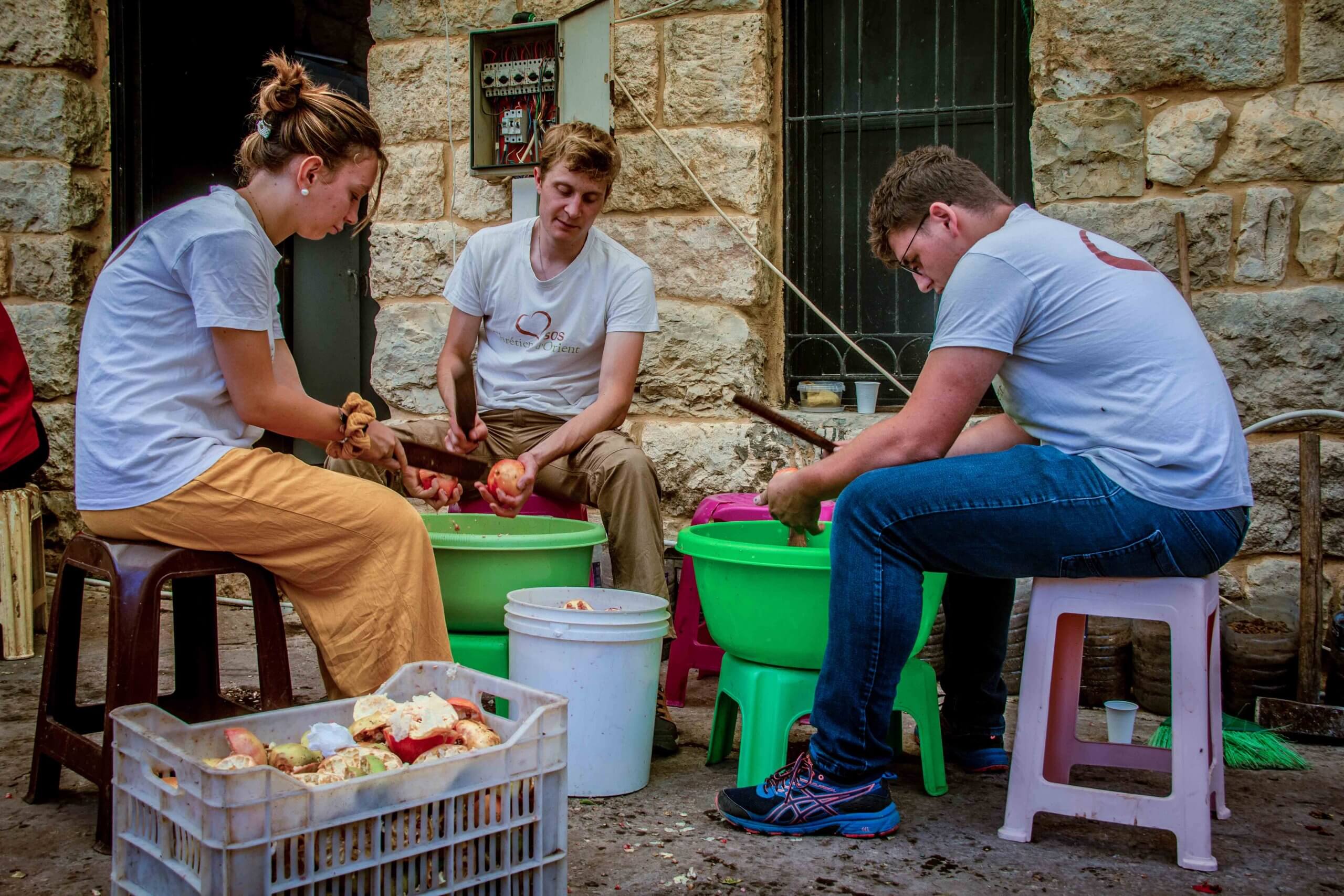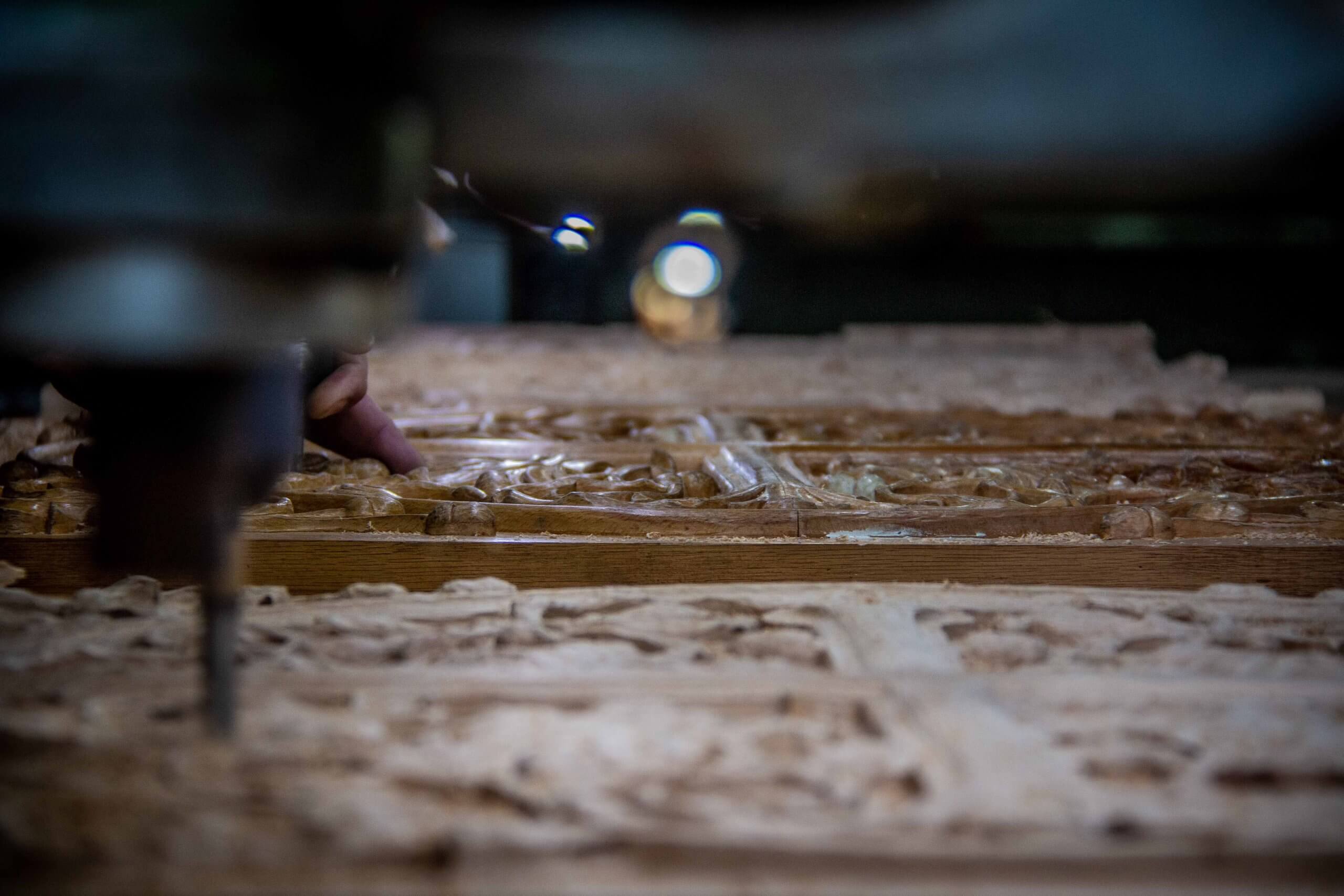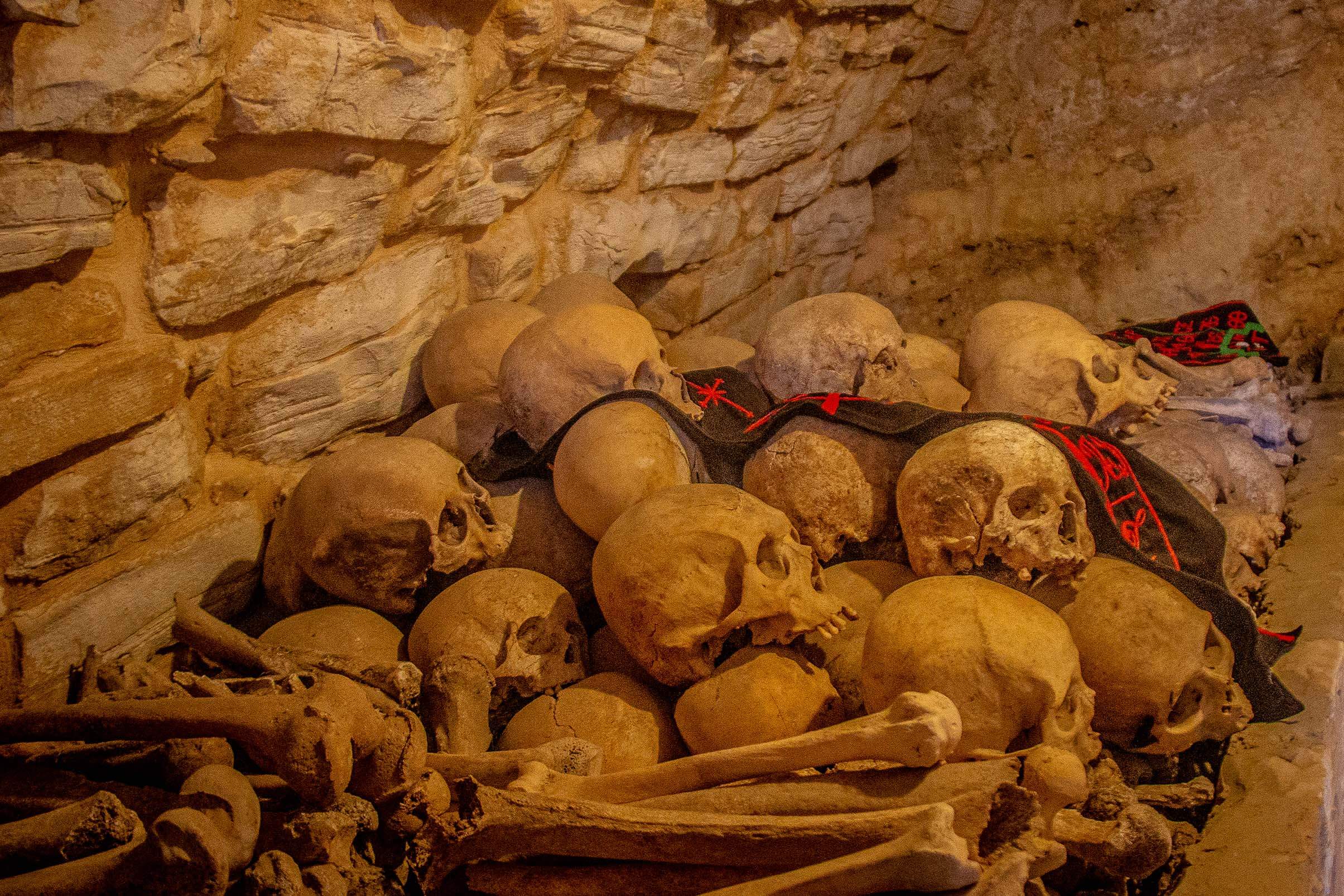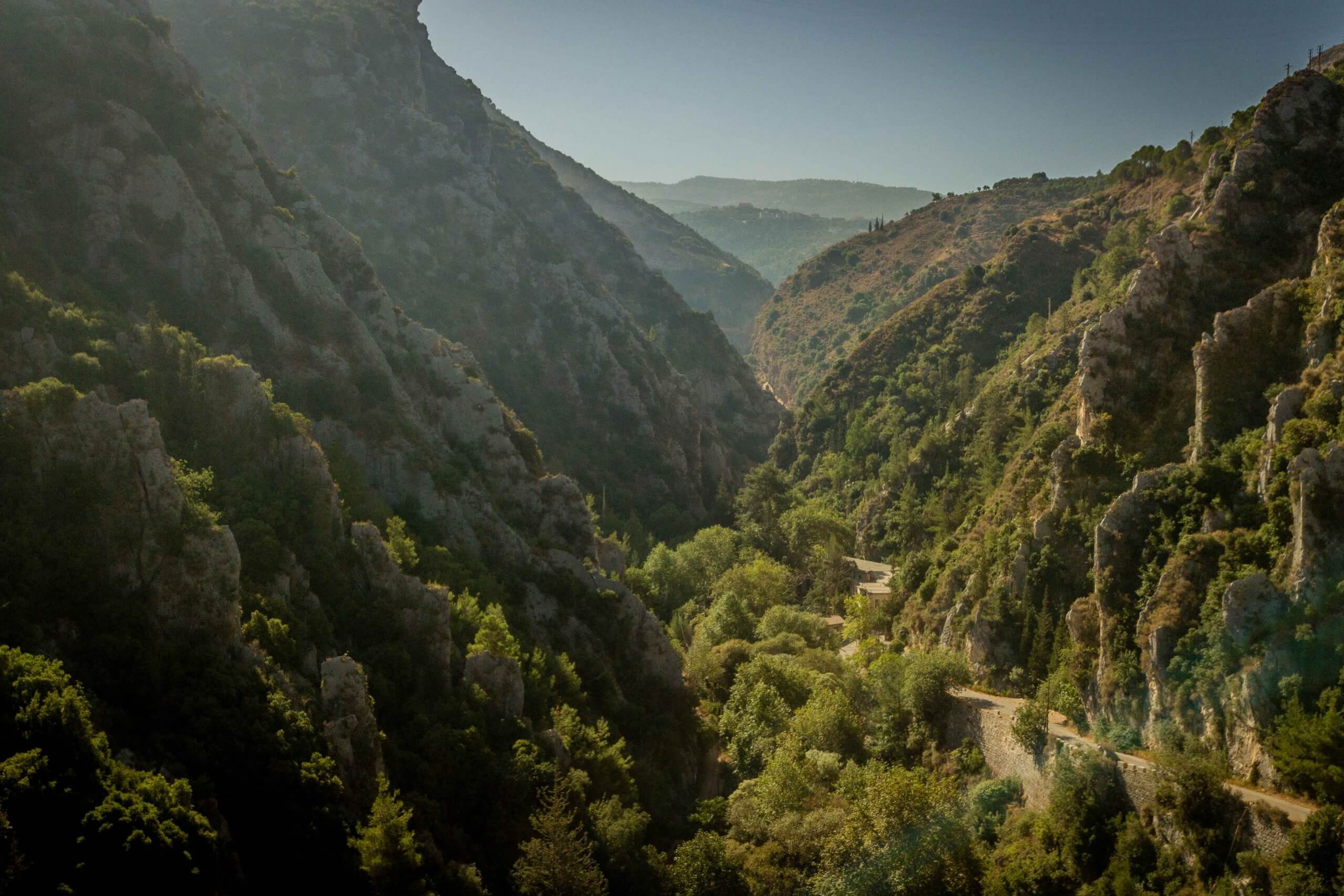For three days, the volunteers shared the daily life of the monks of the Orthodox monastery of Our Lady of Hamatoura. Between a pomegranate-stripping workshop, a visit to the holy place and moments of prayer, they experienced a real retreat in a beautiful green setting contrasting with the narrow streets of the city of Tripoli.
We meet in an old mill at the foot of the mountain where the monastery is located, in the hollow of the Qadisha valley, in a peaceful place bordered by a small stream. What a surprise when we see in the shade of a sun, already hot for the morning hour, about thirty young people aged between 13 and 23 as well as a few adults, busy cutting and emptying the pomegranates. Flat sticks are put at our disposal in order to hit the pomegranate cut in two, to make its numerous pink and translucent seeds fall into basins. The fruit has been collected from the trees on Hamatoura’s property and bought by the monks from poor families to supplement their stocks. We quickly integrate into the serene and joyful atmosphere.

After listening to some songs in Arabic, we also start to sing while continuing to tap rhythmically on the fruits. Brother Seraphim, one of the eight monks of the monastery, honours us with his presence and makes us discover the beauty of the orthodox songs, mainly in Greek. After several hours of ginning, we have lunch by the stream, where we begin to get to know the other workers better. Some speak French well, others don’t. So, we find a way to communicate in a mixture of French, English and Arabic.
Friendships are quickly made and games are organised while we are clearing the grenades. The time comes to transform the arils, the seeds of the pomegranates, into a delicious juice using a machine that crushes the seeds and separates the pink liquid from the deposits.
As the sun sets over the valley, one of the monks takes us on a tour of the mill, which has become a carpentry workshop where furniture is made, as well as various church ornaments, notably the iconostases, partitions decorated with images and icons which, in Orthodox churches, separate the nave from the sanctuary.
We then have to go back to the monastery. Two solutions are offered to us: walking or driving, the monastery being accessible only by the pedestrian way. We hesitate because going back up on foot would allow us to discover this green environment and the beauty of the landscapes of the beginning of the Qadisha valley. But to reach the convent by this way is a real pilgrimage: a walk of two kilometres by stairs and small steep paths. After a hard day’s work, we were getting tired and decided to take the easy way out: the car. We start the ascent by small roads and broken tracks in a 4×4 more than full of exhausted workers. The number of seats being rather small, some of our Lebanese companions even end up on the roof.

We take the opportunity to admire the sunset over the mountains and the monastery nestled in a rocky cavity inside a high cliff overlooking the holy valley of the Qadisha. We are led to our rooms: the girls to a large dormitory and the boys to rooms close to the monks’.
A room-mate tells me that it is advisable to wear a skirt in the monastery. So I swap my work clothes for an ankle-length skirt before meeting my fellow volunteers on a large stone terrace. We start a card game, which is quickly interrupted by the arrival of a monk who tells us that card games are forbidden in the monastery. So we stop playing and start discussing the situation. The young people have no hope for Lebanon. They want to study in France or Australia and for the majority find a job and settle down.
With these defeatist words, exhausted as we are, we decide to return to our beds for a good night’s sleep because tomorrow Brother Seraphim and two of our friends are waiting for us to visit the monastery.
The chapel of the monastery, built in the 4th century, is covered with Byzantine frescos, quite well preserved, dating from the Middle Ages. It also houses a miraculous icon, which was once located in a small church at the top of the mountain. According to tradition, several times during the night, peasants saw a light coming down from the church to the monastery. Each time, the miraculous icon was found in the monks’ chapel. So they decided to leave it there. From then on, barren women came to pray before it in order to have children.

We then go up to a chapel where there are the remains of an Orthodox saint and three martyrs, including a baby. “The relics have a miraculous rose smell,” he says, opening a reliquary for us to smell. The bones do indeed give off a sweet, flowery scent.
Our path then leads us to a rocky cave where we can see the base of a stalagmite. Here, pagan barren women come to pray to the false gods in the hope of becoming pregnant, as this cave was dedicated to the pagan goddess of fertility.
Next door, in an open workshop carved into the rock, monks make candles from honey. We pass the monks’ cemetery where only three graves are visible. “After three years, the bodies of the deceased monks are dug up and moved to a vault.”
We then go down to continue the work of the grenades and discover the magnificent stone staircases blending into the rocks of the cliff. The day passes quickly amidst laughter and singing. The monks also produce cheese and wine which we are lucky enough to taste during our breaks.
As the day fades, we decide to walk back up. The ascent is rather sportive but the joy is even greater at the end. We spend another pleasant evening during which we learn more about the monks. They do not eat meat out of a spirit of penitence and poverty and they distribute a large part of their vegetable harvest, cheese and pomegranate juice to needy families.

Every morning at four o’clock, the monks get up to sing the service. Then, one of the monks makes two sticks clash in a particular rhythm to announce the beginning of the service to the monks and guests.
Despite the early hour, the bravest volunteers get up, fighting sleep to gather and pray. At the end of the service, they do not hesitate to go back to bed for a few hours, in order to resume work later, well rested. But the morning passes quickly and the return to Tripoli is scheduled for 11am. We exchange contacts with our friends and taste some Lebanese specialities cooked in honour of our departure. We leave happy for the help we have been able to give and for all the encounters we have made. Amen to that.
Aliénor, volunteer in Lebanon.